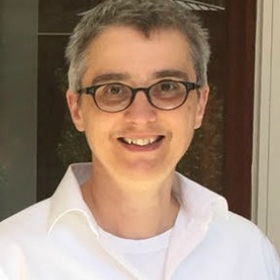

Claudia
Neuhauser
My current position is Associate Vice President for Research and Director of Research Computing in the Office of the Vice President for Research. In my role as Director of Research Computing I oversee the University of Minnesota Informatics Institute (UMII), the Minnesota Supercomputing Institute (MSI), and U-Spatial. UMII fosters and accelerates data-intensive research across all disciplines in the University and develops partnership with industry. My research is at the interface of mathematics and biology, and has ranged from studying the effect of competition on the spatial structure of competitors to the effect of symbionts on the spatial distribution of their hosts or the effect of virotherapy on clusters of cancer cells. Currently, my research is primarily in the area of bioinformatics and computational biology where I am developing statistical methods ranging from detecting genomic signatures of cancer and other complex diseases in next-generation sequencing data to building dynamic protein-protein networks based on flow cytometry data. In addition, I have a strong interest in furthering the quantitative training of biology undergraduate students, which has resulted in a textbook on Calculus for Biology and Medicine.
Shulan Tian; Huihuang Yan; Claudia Neuhauser; Susan Slager. A framework for accurate variant discovery in highly divergent regions. 2016. BMC Genomic 17:703.
S.E.P. Smith, S.C. Neier, B.K. Reed, R.R, Davis, D. Gil, J.P, Sinnwell, J.E. Eckel-Passow, G.F. Sciallis, C.N. Wieland, R.R. Torgerson, Z.Chen, J.McClusky, S.R. Burrows, C. Neuhauser, A.G. Schrum. Multiplex matrix network analysis of physiologic protein complexes in the human TCR signalosome. 2016. Science Signaling 439 rs7 (DOI: 10.1126/scisignal.aad7279)
J.D. Cooper, C. Neuhauser, T. Dean, and B. Kerr. 2015. Tipping the mutation-selection balance: Limited migration increases the frequency of deleterious mutants. Journal of Theoretical Biology, 380: 123-133.
Cradic, Kendall; Murphy, Stephen; Sikkink, Robert; Neuhauser, Claudia; Vasmatzis, George; Grebe, Stefan. 2015. Clinical Validation of a Haplotyping Method with Next Generation Sequencing. Clinical Chemistry 61:2, 430-431.
Cradic, Kendall; Murphy, Stephen; Drucker, Travis; Sikkink, Robert; Eberhardt, Norman; Neuhauser, Claudia; Vasmatzis, George; Grebe, Stefan. 2014. A simple method for gene phasing using mate pair sequencing. BMC Medical Genetics 15:19
N. Beckman, C. Neuhauser, and H.C. Muller-Landau. 2012. The interacting effects of clumped seed dispersal and distance- and density-dependent natural enemy attack on seedling recruitment patterns. Journal of Ecology 100(4): 862-873.
N. Lanchier and C. Neuhauser. 2007. Voter model and biased voter model in heterogeneous environment. Journal of Applied Probability 44: 770-787."
C. Neuhauser, D.A. Andow, G. Heimpel, G. May, R. Shaw, and S. Wagenius 2003. Community Genetics - A Synthesis of Community Ecology and Population Genetics. Ecology 84: 545-558.
P. Chesson, S. Pacala, and C. Neuhauser 2002. Environmental niches and ecosystem functioning. In Biodiversity and Ecosystem Functioning. Pp. 213-245. Princeton.
C. Neuhauser and S. Pacala 1999. An explicitly spatial version of the Lotka-Volterra model with interspecific competition. Annals of Applied Probability 9:1226-1259
C. Neuhauser and S. Krone 1997. The Genealogy of Samples in Models with Selection. Genetics 145:519-534.
Education
Ph.D., Cornell University, 1990
Associate Vice President for Research
Director, Research Computing
Office of the Vice President for Research
HHMI and Distinguished McKnight University Professor
Morse-Alumni Distinguished Teaching Professor
Graduate Faculty Memberships
Ecology, Evolution, and Behavior; Bioinformatics and Computational Biology; Conservation Biology; Stream Restoration Science and Engineering.
Graduate Training
I was the founding Director of Graduate Studies of the Biomedical Informatics and Computational Biology (BICB) graduate program and was in this position between 2008 and 2017. This is an interdisciplinary, all-University graduate program with faculty from the University of Minnesota Twin Cities, University of Minnesota Rochester, Mayo Clinic, the National Marrow Donor Program, and other industry partners. The programmatic focus of the BICB graduate program is at the interface of quantitative sciences, medicine, and biology.
Undergraduate Training
When I joined the School of Mathematics at the University of Minnesota in 1996, I developed a calculus course for biology majors (MATH 1281 and MATH 1282). This resulted in a text book, Calculus for Biology and Medicine (Prentice Hall), which is now in its fourth edition. When I moved from Mathematics into EEB, I wanted to continue my educational efforts. With support from the Howard Hughes Medical Institute, I developed ways to improve the quantitative training of biology majors by integrating mathematics and statistics directly into biology courses.